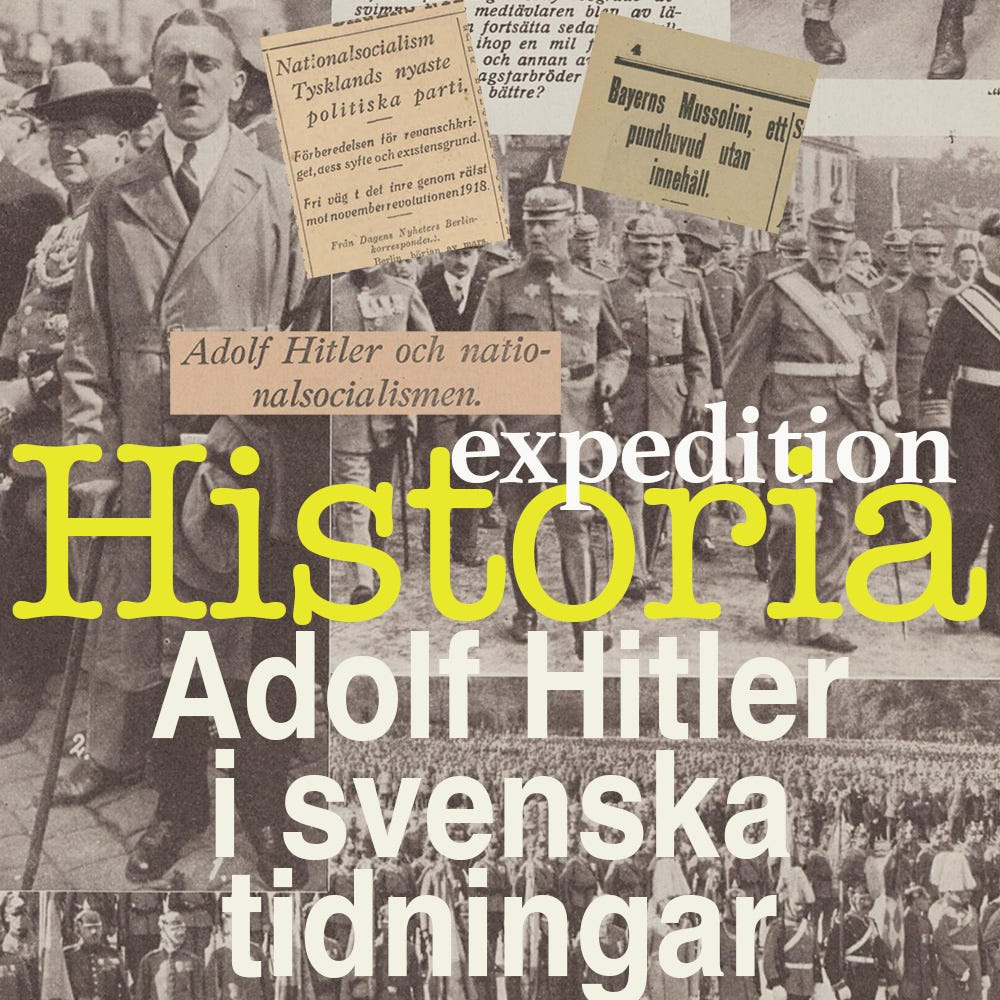Hade Adolf Hitler hela tiden siktet inställt på att förinta Europas judar?
Eller var beslutet om Förintelsen under andra världskriget något som gradvis växte fram och att naziströrelsen radikaliserades efter 1941 års invasion av Sovjetunion?
Och hur skildrades egentligen Nazirörelsens judehat första gången Adolf Hitler nämndes i svenska tidningar, år 1922 och 1923?
English summary:
Expedition history episode 3 - Adolf Hitler in Swedish newspapers
Did Adolf Hitler have his sights set on exterminating Europe's Jews all along? Or was the decision about the Holocaust during World War II something that gradually grew and that the Nazi movement was radicalized after the 1941 invasion of the Soviet Union?
And how was the Nazi movement's Jew-hatred actually portrayed the first time Adolf Hitler was mentioned in Swedish newspapers?
This is Expedition History, Episode 3.
This episode is about Adolf Hitler's early period as leader of the National Socialist Party. And I want to warn already now that there are descriptions of terrible events and abhorrent statements in this episode that I personally strongly distance myself from, but which in a historical context are important to highlight because this movement marked the history of the 20th century like no other.
Ever since the end of World War II, there has been a debate among historians as to whether the Holocaust of six million Jews was the result of a grand plan, or whether it was a gradual process in which the Nazi movement radicalized after 1941 into what is now known as the Holocaust.
The fact that there is no written order with Adolf Hitler's name on it stating that he orders the extermination of Europe's Jews has led to speculation about Hitler's role and how planned the Holocaust really was.
In this program we will take a look at the early reporting that took place around the Nazi movement and Adolf Hitler as a person, based on articles and interviews in Swedish newspapers in the early 1920s
Very recently the Royal Library made available all papers from 1923 and early 1924. Then it is interesting to read how the newspapers wrote about Adolf Hitler before the journalists of the time knew anything about the Second World War, the Holocaust and all the blood, all the death and all the destruction that would follow in this man's footsteps.
So how much did Adolf Hitler really reveal in 1923 about what he wanted to accomplish?
Adolf Hitler himself is mentioned for the first time in a Swedish newspaper at the end of 1922.
The newspaper Sydsvenska dagbladet exclaims that "Bayern has got its Mussolini", and compares Italian fascism with the new National Socialist movement. The newspaper states that the National Socialists are strongly anti-Semitic and that they believe that no national goal can be won unless the Jews are put out of the game.
In February 1923, Aftonbladet portrays the National Socialist movement. The headline reads "anti-Semitism as a counter-movement" - that Nazism was anti-Semitic is therefore clear from the very beginning. This is what it says in Aftonbladet: "From today's storehouse of contentious issues, I want to bring out one that, for the time being, lies far away from the people of northern Europe. But for the people of Central Europe, the Jewish question is extremely relevant".
After this article comes several others during 1923 where Swedish journalists managed to get an interview with the famous leader Adolf Hitler. One who makes an attempt to get an interview with Hitler is Sydsvenska Dagbladet's correspondent who simply knocks on the door of Völkishcer beobachter, the Nazi newspaper whose newsroom Hitler used to hang out at. Hitler believes that Germany's state of emergency was created by European Jews with the intention of pushing the Jewish Marxist revolution further. The only alternative is - according to Hitler - a "dictatorship of the will" and precisely in Berlin the German revolution of 1918 will see its end, and we do not intend to show any mercy.
Another of the contemporary journalists, in Gothenburg's trade and shipping newspaper, calls Hitler an anti-Semitic leader with a program that is a most remarkable mixture of realpolitik and romantic speculative utopias, the whole imbued with a completely "brutal and pogrom-ripe anti-Semitism".
In one of the very first newspaper articles in which Bavaria's Mussolini is mentioned, it is stated that the leader of the National Socialists is called Michael Hitler, who has great agitator talent and is a demagogue to the tips of his fingers. They have decided to "remove the socialist leaders and incite the murder or at least the expulsion of all Jews".
In Gothenburg's trade and shipping newspaper it is stated that the nationalist program consisted of "extermination of everything called Jews and socialists in Bavaria".
In the Trelleborg newspaper it is stated that the National Socialists' main program item is "away with the Jews"
In Aftonbladet it says that National Socialism is furiously anti-Semitic and wants to drive the Jews out of the country with all its might.
Dagens Nyheter writes in the fall of 1923 that if Hitler comes to power, you can expect Jewish pogroms "If Hitler comes to the helm, it will be a time of haunting for the Jews," it says.
That Hitler was anti-Semitic, hated Jews and that he wanted to forcibly exterminate or expel them from the German Reich must have been clear to those who read the Swedish newspapers in 1923.
It is clear that Nazism is violent and aggressive, that it wants to target the Jews, expel them or exterminate them. That they are looking for a revenge war after the First World War and that all this will happen when parliamentary system and democracy have been crushed.
Of course, it is not described how this would happen in practical terms, who would design, plan and implement the plans.
And therefore one should not focus at this stage in the history of Nazism on how they should proceed, but instead see that it was underway and that the political goal was there.
What happened in the 1920s was to prepare the way for what was to come. There would be a war of revenge, in that war the Jews would be forced out or exterminated.
The ideological basis that created the conditions for Nazism to exterminate and murder millions of people during the Holocaust was thus formulated - and as we have seen also published, in Sweden, as early as 1923.














Expedition: Historia – Avsnitt 3: Adolf Hitler i svenska tidningar